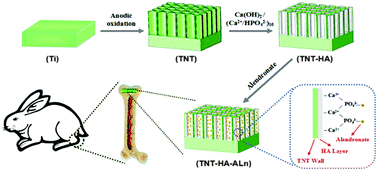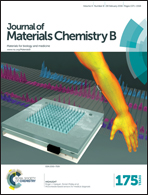Alendronate-loaded hydroxyapatite-TiO2 nanotubes for improved bone formation in osteoporotic rabbits
Abstract
Early mechanical fixation between an implant and native bone is critically important for successful orthopedic implantation, especially for hosts suffering osteoporosis with reduced bone mass. To endow a titanium-based implant with a desirable local anti-osteoporosis property for enhancing its early osseointegration, alendronate-loaded hydroxyapatite-TiO2 nanotube (TNT-HA-Aln) substrates were fabricated and systematically characterized in this study. The results of Aln/Ca2+ release and Ca2+ concentration in an osteoclast medium verified that the release of Aln was significantly accelerated along with the acidity rise caused by osteoclast differentiation. Other in vitro tests, such as CCK-8, alkaline phosphatase (ALP), mineralization, gene expression (Runx2, Osterix, ALP, Col I, OPN, OC, OPG and RANKL), protein production (OPG and RANKL) and tartrate-resistant acid phosphatase (TRAP), proved that TNT-HA-Aln substrates have great potential for improving osteoblast proliferation/differentiation and inhibiting osteoclast differentiation. Moreover, in vivo tests, such as the push-out test, micro-CT and H&E staining proved that TNT-HA-Aln implants could efficiently improve local osseointegration after implantation for 3 months. The study provides an alternative to exploiting drug–device combinations to enhance early osseointegration in osteoporosis.


 Please wait while we load your content...
Please wait while we load your content...